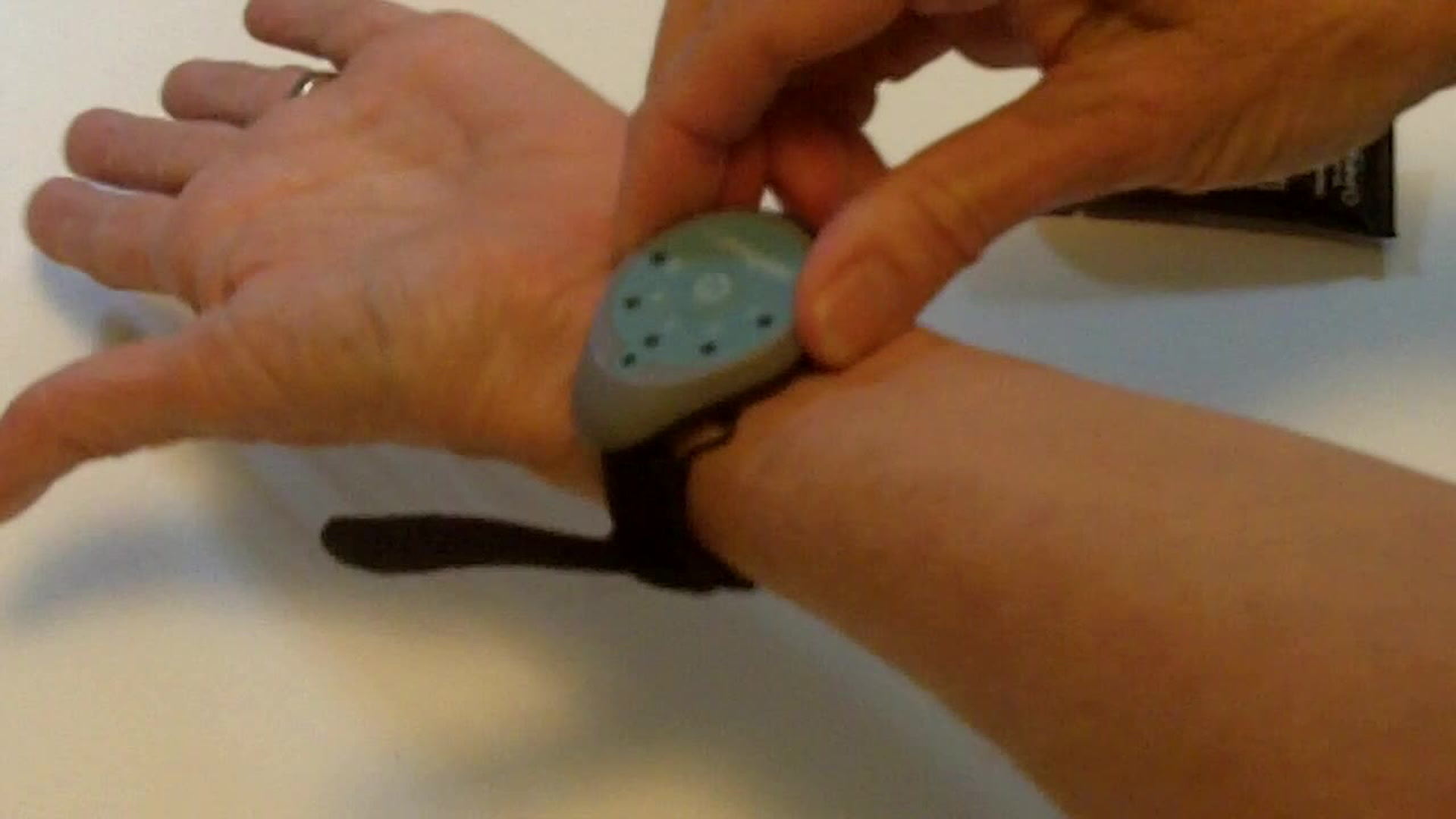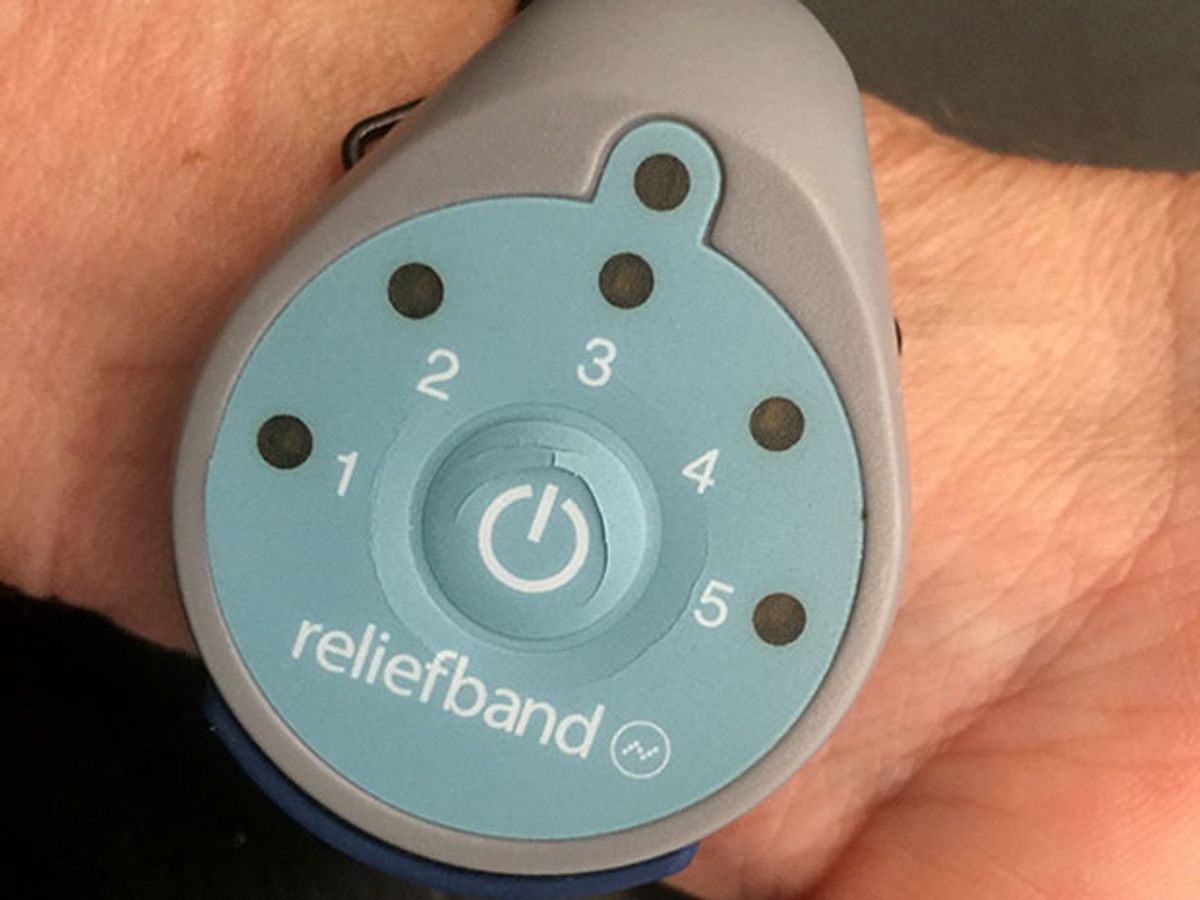I suffer from motion sickness. Bad motion sickness. Non-medicated, I can’t be a passenger in a car for more than 10 minutes of city driving—5 minutes on a windy road—without feeling sick. Virtual reality? Forget it, even with a double-dose of sleep-inducing medication, I can only spend about eight seconds in VR without the warning signs of an impending wave of nausea. (That’s a big problem for a journalist trying to cover consumer electronics these days.) I’ve tried chomping on ginger and ginger-filled capsules, pushing on acupressure points, and all sorts of prescription and non-prescription pharmaceuticals, settling on meclizine as my go-to; trading off 24 hours of annoying but not intolerable sleepiness and a slightly fuzzy brain for a calm stomach.
So when I spotted the ReliefBand booth at CES this year, touting a wearable that uses electric pulses to block the neurological signals that kick off motion sickness, I was eager to try the device—but was more than skeptical. I was sure that it wasn’t going to work, because if this really were possible, wouldn’t someone have thought of it years ago?
It turns out that someone did—about 20 years ago, and it’s been marketed for at least a decade as a prescription device to hospitals. And the various companies that owned the technology along the way made occasional attempts to break into the consumer market.
But more on that later.
What you probably really want to know is if the $90 gadget works. And oh yeah, it works. Amazingly, quickly, absolutely. And it is changing my life.
I first got an evaluation unit from ReliefBand in February. That evening, my husband and I had tickets a show in San Francisco; in rush hour, that’s anywhere from an hour to an hour and a half away, much of it in heavy traffic. I hate navigating the traffic and the city driving, so my usual plan would have been take a meclizine earlier in the day and hope it doesn’t knock me out during the show. I decided to instead try the ReliefBand, warning my husband that if it doesn’t work it could be a rough evening.
The device isn’t intuitive to use; even though the brochure says “slip it on your wrist” you have to follow instructions, though they are straightforward: measure two finger widths below the crease of your wrist and feel for a spot between the two tendons, rub in some of the conductive gel included with the product, then strap it on. Push the on button; push it again to raise the level of electricity until you feel it down to your middle fingertip: there are five levels, I felt a noticeable, but not uncomfortable, tingle at level 2.

It was a hairier drive to the city than usual that evening—due to road closures for Super Bowl events in San Francisco, we had to turn the navigation over to Waze, which sent us winding through narrow alleys and making frequent turns to get to our destination. To my shock, I felt fine. Absolutely fine. And my husband was feeling pretty good as well. “That’s the first time we’ve ever gone anywhere that you haven’t at least sighed, if not complained, when I came to a fast stop,” he told me. I turned the ReliefBand off as soon as we parked, and felt that momentary pre-nausea feeling. I turned it back on, and it went away. I decided to give myself five minutes to stabilize as we walked to the theater, after that, I was fine.
A few days later, I was driving my son over to Santa Cruz on Highway 17—a twisty mountain road, the motion effects worse on a sunny day as the light strobes through trees. I was fine, because I was driving. He isn’t super sensitive to motion, though mountain roads sometimes affect him, and checking his phone for texts doesn’t help. About half way there he put his phone down and stared straight ahead. “Mom, I think I’m getting sick.”
“I have that gadget in my purse if you want to try it.” I talked him through putting it on. And five minutes later he was madly texting (I’m not so sure that’s a win, but at least he wasn’t sick.)
Since then, I’ve been using the ReliefBand in just about every situation in which I would normally pre-medicate with meclizine. In April, we took a cruise. Let’s just say I took far more advantage of the nightlife this time, not having to fight the meclizine sleepies. I hardly turned it on after the first day—cruise ships are pretty stable until they aren’t—at which point, I’ve learned on past trips, it’s too late to medicate. The only time I medicated (and got sick anyway) was for a snorkel trip, not exactly a situation in which I could wear an external electrical device. However, though I did get sick, I do believe the gadget helped me recover faster—typically, I would have been sick all afternoon, and needed at least a two-hour nap to reset my stomach. I did lie down and close my eyes for a while, but using the wearable I was happily eating lunch in a little over an hour.
These days, I also use a ReliefBand in situations that I wouldn’t have medicated for, but that sometimes prove stressful—like all cab and Uber rides, even short ones (you never know if the driver or road conditions are going to be motion-sickness friendly).
Finally, in May I gave ReliefBand the ultimate test: virtual reality. As a New York Times subscriber, I received Google’s cardboard VR glasses, a low-cost version with a relatively sluggish response to real-world motion guaranteed, for me, to trigger nausea in seconds. I won’t say ReliefBand solved the problem, but I was able to tolerate about half a minute before the symptoms got worrisome; that leads me to think that I might be able to spend a few minutes with ReliefBand and a better VR system.
While I’m clearly in love with the gadget’s function, its form leaves a lot to be desired. It’s too big and the hard plastic shell makes it seem like a cheap toy—it reminds me a lot of a wearable “compass” that came in a $10 explorer’s kit for four year olds (along with useless binoculars and a canteen). Still, wearables are so common these days that even chatty Uber drivers didn’t question what I was fiddling with on my wrist, assuming it’s some kind of sport watch . And the small flexible battery door is a disaster, nearly impossible to close once opened.
CEO Nick Spring admits to all of this. In addition to my criticisms, he pointed out that the strap is hard to manage one-handed; that’s because, he says, it was designed for nurses to put on patients, not for people to use themselves.
Here’s that backstory I promised. Nearly 20 years ago, Spring said, a group of researchers at a California company, Woodside Biomedical, working with researchers at Penn State University, came up with a device called Accutens that, they determined, by electrically stimulating the T6 acupuncture point on the wrist, worked as well as current medications to prevent motion sickness. In the early 2000s, Abbott Laboratories purchased Woodside and began developing the technology into a product. Abbott later spun Woodside out again. Along the way, the device received FDA clearance for use in chemotherapy and post-operative sickness, and made some inroads into hospitals as a prescription-only device; a later prescription-only version, the PrimaBella, got some traction as a treatment for morning sickness. A nonprescription version was marketed at various times to pilots and boaters. The current version is an update of that model.
Spring came on the scene in late 2014, joining the company and leading a management buyout in July of 2015, at which point the company changed its name to ReliefBand Technologies and by December had scooped up US $5 million in venture capital.
“With the evolution of Fitbit and other wearables,” Spring said, “wearable technology has come of age. And, it seemed, the next evolution of the market, from wearables that measure to wearables that actually provide therapy, was about to come. ReliefBand offered that kind of solution, though the design was pretty basic.” Spring also said attention that’s lately come to neuromodulation technology has made people more comfortable with the idea of using electricity to affect the nervous system.
Now, he says, the company is in the midst of a major redesign, updating the electronics to reduce the size, changing the material, switching to a rechargeable battery, making it water resistant—essentially, turning it, he hopes, into a hip-looking wearable. Future versions, he says, will communicate to mobile phones, relying on smarts in the phone to determine when your world is rocking and turn the wearable on automatically. What he’s not changing, he says, is the algorithm that triggers the electric pulses. “If you stimulate the nerve constantly, it stops reacting,” Spring says. ReliefBand says it has figured out how to time the pulses so they are frequent enough to block nausea but not so frequent as to have the nerve tune them out.
Spring expects to unveil the new version at CES 2017. I plan on being one of the first in line to buy it, and if it’s cute enough, it just may join the Fitbit on my wrist daily. In the meantime, I carry the current version with me, ready to strap on, always.
Correction made 12 May 2016.
Tekla S. Perry is a senior editor at IEEE Spectrum. Based in Palo Alto, Calif., she's been covering the people, companies, and technology that make Silicon Valley a special place for more than 40 years. An IEEE member, she holds a bachelor's degree in journalism from Michigan State University.



